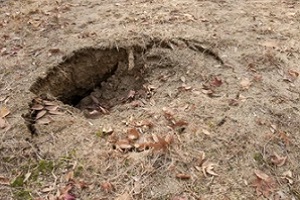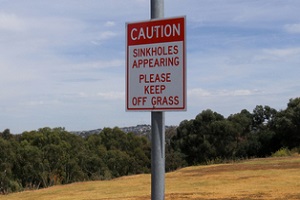 For many homeowners, swimming pool removal is a way of getting the yard of their dreams. Whether their swimming pool is not getting much use or homeowners are looking to eliminate the hassle and expense of pool maintenance, swimming pool removal is a great way to add significant space to the yard that can be used for a range of purposes. However, when a swimming pool removal is not carried out correctly, there is the possibility that sinkholes could develop and that dream yard could quickly become a nightmare.
For many homeowners, swimming pool removal is a way of getting the yard of their dreams. Whether their swimming pool is not getting much use or homeowners are looking to eliminate the hassle and expense of pool maintenance, swimming pool removal is a great way to add significant space to the yard that can be used for a range of purposes. However, when a swimming pool removal is not carried out correctly, there is the possibility that sinkholes could develop and that dream yard could quickly become a nightmare.
Why Can Pool Removal Cause Sinkholes?
When the foundation of a pool is not properly refilled, it can lead to sinkholes. Sinkholes are most common in terrains that have carbonate rock, limestone, gypsum or salt beds that may dissolve. As water eats away at the rock, a pit is eventually formed. When the sediment layer on top of the pit loses its support and collapses into the pit, this creates a sinkhole.
Following a faulty pool removal, there are two main types of sinkholes that may be seen. One is a cover subsidence hole. This occurs when permeable sediment is placed over soluble rocks such as limestone. When the rock dissolves, the sediment will slowly sink until a depression is created in the ground.
Another type of sinkhole that may be seen after a pool removal is a cover collapse sinkhole. This dangerous type of sinkhole can be avoided with proper vigilance during the pool removal process. Cover
collapse sinkholes often occur in a matter of minutes and may be triggered by weather events such as heavy rainfall. This causes the sediment covering the void beneath it to suddenly collapse, leaving a hole behind. This type of sinkhole can develop almost anywhere.
How Can Sinkholes Be Prevented?
Sinkholes are very easy to avoid if a pool removal is carried out properly. Nearly every pool removal sinkhole can be traced to shoddy work or inexperienced contractors. Working with a reputable pool removal contractor is an easy way to avoid sinkholes as they will take all of the necessary precautions to reduce the chances that sinkholes will form.
 For example, they may lay down a special type of geotextile fabric across the rubble of a partial removal to prevent fill soil from falling through. A contractor is likely to use a vibratory trench roller to compact the fill material into the pool cavity.
For example, they may lay down a special type of geotextile fabric across the rubble of a partial removal to prevent fill soil from falling through. A contractor is likely to use a vibratory trench roller to compact the fill material into the pool cavity.
Although some contractors may use a skid loader for compaction, this is not recommended if you want to avoid sinkholes. Trench rollers are the most secure way to compact fill dirt, creating a tight seal over the cavity left behind by the pool to prevent sinkholes from occurring and create a solid foundation on which outdoor features such as patios and gardens can be installed.
Ensuring Pool Materials Are Properly Broken Up
A qualified contractor can ensure that the pool materials are broken up properly to avoid the risk of moisture becoming trapped in the concrete and other pool components that remain when a partial removal is chosen.
This can push the pool upward to the surface, leading to expensive repairs. Professionals can break up the components and push them into the pool to fill the cavity properly, reducing the amount of fill and gravel that is needed, thereby leading to cost savings.
After the debris has been crushed and tamped down, gravel can be added to the pool cavity using one-foot layers. Each of these layers must be compacted down fully before the next one is added. The gravel foundation that this provides will keep the pool debris underground and serve as a foundation for the soil.
Although soil will shrink and decompress over time, the layer of gravel beneath will remain firmly in place. In some cases, a pool removal contractor may also install a PVC pipe along the former pool’s length to help it drain properly and prevent any underground water from causing a mudslide for additional peace of mind.
Proper Topsoil Placement
Once the gravel has been placed, many homeowners choose to have topsoil added for landscaping purposes or aesthetic purposes. This is something that should be done by a professional to ensure the integrity of the yard itself.
The soil needs to be at least three feet deep if the homeowner intends to plant any crops, flowers or grass on it; if trees will be planted, the soil layer needs to be even deeper. A good contractor can do this in a way that will make the yard appear as though a swimming pool never existed there.
Paying Attention To The Signs Of Sinkholes
Although you are unlikely to experience sinkholes in your yard if you entrust your pool removal to the experts, you still need to be aware of the warning signs of impending sinkholes so that you can act before they occur.
 If you notice any trees or fence posts in your yard slanting, sagging or slumping, you should seek professional help. In addition, cracks in the wall, pavement or floors of structures in your yard could be a sign of a sinkhole.
If you notice any trees or fence posts in your yard slanting, sagging or slumping, you should seek professional help. In addition, cracks in the wall, pavement or floors of structures in your yard could be a sign of a sinkhole.
If a sinkhole appears that is posing a direct threat to your home or structure, it is important to get out immediately and report the issue to emergency personnel and a building inspector. Wait for an official inspection to determine whether it is safe to return.
Reach Out To The Experienced Pool Removal Contractors
Filling in an inground swimming pool carries many risks when it comes to the stability of your yard. To avoid damage to your yard that can be dangerous and expensive to fix, get help from the pool removal contractors at Dirt Connections.
Our team has the experience, tools, equipment and materials to get the job done safely and reduce the chances of sinkholes occurring. To schedule a pool removal project or get more information about our process, get in touch with our qualified pool removal experts at Dirt Connections today.
Summary

Dirt Connections was started with one goal in mind: providing quality residential and commercial construction services to clients on time and on budget. Reach out for more information on how we can support your next project.
For your convenience our estimates are free and by appointment. Call 703-940-9949 for a free estimate today!









































